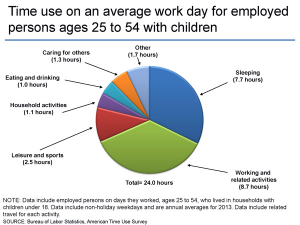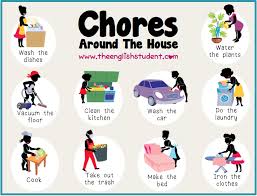Are you frustrated by a lack of time to do the things you want? Or even to do the things you have to get done? Managing work, a household and finding time for family activities is not easy in today’s busy family schedule.
In a 24-hour period of time, sleep, work and work-related activities take the bulk of the schedule used in our daily lives; this is a no brainer. So, where does the rest of the time go? Commuting, caring for others, eating, drinking, household chores, as well as, leisure activities. So often, families find that leisure time is absorbed by the other categories; this is easy to do.
![extracurricular_article[1]](https://livesmartohio.osu.edu/files/2015/04/extracurricular_article1-300x173.jpg) For example, extracurricular activities are a great way to extend supervised activities, as well as, develop many types of skills. Also, children respond well to the structure it provides. However, the activities and scheduling, multiplied by the number of children a parent is providing for, stretches the already vulnerable family schedule too thin.
For example, extracurricular activities are a great way to extend supervised activities, as well as, develop many types of skills. Also, children respond well to the structure it provides. However, the activities and scheduling, multiplied by the number of children a parent is providing for, stretches the already vulnerable family schedule too thin.
The result of over engagement has long-term consequences for children and parents alike. Spreading yourself too thin lessens your ability to focus and produce good results on any one thing, including relationships and skills.
Take a moment and step back from your day and look at how you spend it. Keep a time diary for a few days, noting specific activities and the amount of time they take. Then take time to identify individual and family goals. If your activities and goals are not aligning, it is time to make some changes.
Balance brings an uncanny happiness and success for all members of the family. Naturally, starting in the family home is key. A 2007 Pew Research Poll found that sharing household chores was the third most important factor for a happy marriage. And so, it should be duly noted, that when parents are in harmony, children will find more harmony as well.
So, how do the chores get divided among family members? There are a variety of successful methods. Here are few worthy of mentioning:
Resource method: Select a person who has the time, energy and skill to do the job. This includes age appropriate work for all members.
Rotating chores method: In this method, chores are rotated among all members. Everyone tries all tasks, although some training may be needed and standards will vary week to week.
Each-person-for-himself method: Each person is responsible for his or her own food, clean-up and laundry. Some yard work and house repairs may need to be considered.
Substitute method: This method results in goods or services that are bought in order to save time (convenience foods, cleaning help, dining out).
Not one method serves all needs and can at times be very costly, in relationship and budget. Consider what works best for your family. Each person for himself may be a good compromise for a busy week night schedule, but then again, perhaps it is time to shift ownership to a new member of the family. Such decisions can be deferred to the “Who does this now? Who could do it?” activity.
As a family, identify who usually . . . Prepares the meal? Cleans up after dinner? Washes the car? Completes yardwork? Does the grocery shopping? Plans the menu? Attends appointments & events? Pays bills? Completes household repairs?
Then talk over the possibilities of who can also complete the tasks. Whatever you discover as a family, will add to the adventure of family successes. Above all, make time for those things that are truly important and valuable for you and your family.

![couple-painting[1]](https://livesmartohio.osu.edu/files/2015/04/couple-painting1-300x200.jpg)
